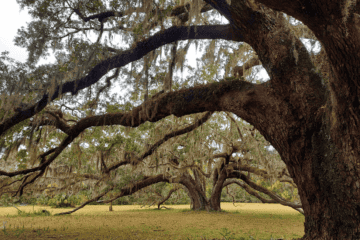Marching to the Sea: Cumberland Island and Loggerhead Sea Turtles

It is that time of year. At Cumberland Island’s beach, a spot of sand stirs and develops a depression, and little leathered heads emerge. It is loggerhead sea turtle hatching season. After incubating for two months, these tiny two-inch-long creatures leave their nest and instinctively make their way to the ocean. Below, discover the loggerhead sea turtle’s remarkable journey and Cumberland Island’s role in that process.
World Travelers
Sea turtles have traveled great portions of the earth for over 100 million years. These highly migratory creatures are large, air-breathing reptiles that inhabit tropical and subtropical seas. While there are seven species of sea turtles worldwide, Cumberland Island hosts mainly loggerhead nests with a few green sea turtle nests.

The Loggerhead
The loggerhead sea turtle receives its name from its large head which supports powerful jaw muscles, enabling it to feed on hard-shelled prey such as whelks and conch. Loggerheads in the southeastern U.S. weigh an average of 250 pounds and are generally about three feet long. They are long-lived, surviving 70 to 80 years or more, with female loggerheads reaching sexual maturity at about age 35.
‘Tis the Mating Season
Every two to three years, females mate in coastal waters and use the earth’s magnetic field to navigate to the same beach where they hatched decades earlier to nest themselves. In the northern hemisphere, mating occurs in late March to early June, and females lay eggs between late April and early September. Adult females lay eggs in three to five nests two weeks apart during a single nesting season with nest containing about 100 eggs. The temperature of the sand determines the hatchlings’ sex: cooler temperatures produce males and warmer temperatures produce females.
Researchers theorize loggerhead hatchlings and juveniles spend their earliest, most vulnerable years – the first seven to fifteen years of their lives – floating around the sea in giant beds of sargasso weeds where they do little more than eat and grow. After this period, they appear at feeding grounds in nearshore waters where they forage and continue to grow for several more years. Adult loggerhead turtles migrate hundreds of thousands of miles from their foraging grounds to their nesting beaches.
Cumberland’s “Easter” Egg Hunt
Loggerheads are the most abundant species of sea turtle which nests in the United States, primarily along the Atlantic coast from Florida to North Carolina and in the Gulf of Mexico along the Florida and Alabama coasts. The United States hosts more than 100,000 loggerhead sea turtle nests per year.

This year, Cumberland Island is sheltering 1,026 of these nests (all but six of which are loggerhead nests), making the island’s 18-mile undeveloped beach one of the most important loggerhead sea turtle nesting areas in Georgia. Each year the island accounts for 25 to 30 percent of the statewide nesting total.
Cumberland’s sea turtle monitoring program utilizes interns and volunteers who patrol the beach each year from May through October locating nests, monitoring them, protecting them from tidal wash-overs and predation, and inventorying them after hatching to evaluate success.
Save the Turtles
Over the last 200 years, sea turtles have been slaughtered for their eggs, meat, skin, and shells and have suffered from poaching and over-exploitation. They also face habitat destruction and accidental capture – known as bycatch – in fishing gear. The use of turtle excluder devices (TEDs) in shrimp trawls, gillnet bans, and other gear modifications has reduced some sea turtle bycatch, but it still remains the biggest threat facing loggerheads.
Nearly all species of sea turtle are now classified as endangered with three of the seven species critically endangered. In the U.S., the loggerhead sea turtle is listed as threatened, but internationally both it and the green sea turtle are endangered.

How can you help? Become better informed about sea turtles through Cumberland resident Carol Ruckdeschel’s books, Sea Turtles of the Atlantic and Gulf Coasts of the United States and A Natural History of Cumberland Island; contact the Georgia Department of Natural Resources at 800-2-SAVE-ME if you see a sick, stranded, disoriented, or dead sea turtle; or volunteer (call 912-882-4336 ext. 228) or intern (visit https://www.thesca.org/) on Cumberland Island. Finally, voicing your concerns to elected officials or supporting respected organizations such as the Sea Turtle Conservancy can further help protect these creatures.
We are lucky that such a miracle of life occurs annually on Cumberland Island. Let us help protect this ancient process to ensure it continues!
Learn more about sea turtles and Cumberland Island’s ecosystem on our Cumberland Island Walking Tour!


